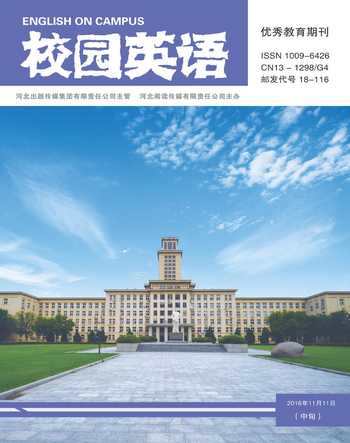The Flipped Classroom Model in ISLA
2016-05-30周洋洋
1. Introduction
The one who first carried out the researches on flipped classroom is a professor of physics at Harvard University, Eric Mazur. Intended to make learning much more energetic, he created the peer instruction in 1990s and this method so far has already experienced ten-year explorations. Eric Mazur thought that learning can be divided into two steps. First is the knowledge transmission and second is absorbing process. Traditional teaching paid much attention to the first step while neglecting the second step. According to researches, peer instruction method could accelerate the second step to double the accuracy. In 2000, Maureen Lage, Glenn Platt and Michael Treglia together published a paper about flipped classroom in Miami University when set up a course in economy. They talked about how to take full use of flipped classroom to activate teaching to adapt to different learning styles. In the 11th international teaching congress, J.Wesley Baker proposed that teachers should be the guiders instead of passers. In the autumn of 2000, The University of Wisconsin Madison formally applied flipped classroom in computer courses in which videos are put online to allow students watch at their breaks. This method also allows students to solve problems with teachers in the class in order to increase the communication between teachers and students. In 2007, Jeremy Strayer wrote his doctoral thesis about flipped classroom which talked about the arrangement conditions of flipped classroom in universities. A young man called Salman Khan unintentionally launched a revolution when he tutored his sister after he put some video resources for study online. Now flipped teaching model has been popular in many countries in academic circle.
2. The classic study on flipped classroom model
In the paper Quasi-experimental Study on Flipped Classrooms Impact on the University Teaching Effect by Pan Bingchao, the study adopts quasi-experimental method. The author compares two groups of Chinese primary students: one group is under the guidance of traditional teaching model while the other is a flipped teaching model. The study intends to analyze and compare the results of the two models and make sure what effects does flipped classroom model have on the results. From the three parts of the whole experiment, here comes the conclusion that as compared to traditional model, flipped classroom model has vital significance on teaching reformation and efficiency improvement.
In the paper The research of flipped classroom teaching model based on Micro-video by Chen Huiyuan, the study uses the research of literature, case analysis method, the method of questionnaire survey and experimental education method. The study is based on mastery learning theory, ubiquitous learning theory, theories of motivation and relevance theory. Based on micro-video on the basis of previous studies, and analyses key elements of the model, the study structures flipped classroom teaching model. It has activities before the class, in the class and after the class.
3. The importance of flipped classroom model in ISLA
From previous classic studies, flipped classroom model has vital importance on Instructed second language acquisition (ISLA).
First flipped model has obvious advantages on stimulating and maintaining students learning motivation as well as cultivating the competence on independent study and cooperative learning. Second effective flipped classroom could give the new requirements to college teaching. Third flipped classroom teaching model based on micro-video can excite students' interest of learning and improve students' initiative of learning. Four flipped classroom teaching model based on micro-video can embody the tutor of teachers and the dominance of students. Five flipped classroom teaching model based on micro-video contributes the interactive relationship between teachers and students and improves students' self-learning ability, the ability to find and solve problems, team collaboration capabilities, expanding innovation capacity. Six flipped classroom teaching model based on micro-video contributes teachers to grasp learning process better, and help parents provides a visualization window that understands students' learning process.
However flipped model has its limitation. It has no more advantages over traditional model on imparting the knowledge of concepts and theories. Moreover it would take much more time to organize the teaching activities, which might make classroom teaching lose plan and efficiency. In addition, it requires more competence on self-management and independent learning of college students.
References:
[1]Rebecca S.The Flipped Classroom:A disruptive revolution in pedagogy,or yet another educational fad?
[2]陈会源.基于微视频的翻转课堂教学模式研究.2015.
[3]何朝阳,欧玉芳,曹祁.美国大学翻转课堂教学模式的启示[J].高等工程教育研究,2014,(2):148-151.
[4]王素敏,张立新.大学英语学习者对翻转课堂接受度的调查研究[J].现代教育技术,2014,(3):71-78.
作者简介:周洋洋(1990-),女,汉族,河北保定人,山西财经大学经贸外语学院2014级外国语言学及应用语言学专业研究生,主要研究方向:教育。
猜你喜欢
杂志排行
校园英语·中旬的其它文章
- 大学英语教学中翻转课堂应用关键问题探讨
- 体育院校外语课程设置与运动员职业发展关系
- The Comparative Study of Native and Nonnative English Speaking Teachers’ Interaction in College English class from the Students’Perspective
- 大学英语翻转课堂教学模式的应用及效果研究
- 浅议书面表达中的回避策略
- The Feedbacks of English Education Majors on Computer Assisted Teaching Through Blackboard Academic Suite Online
